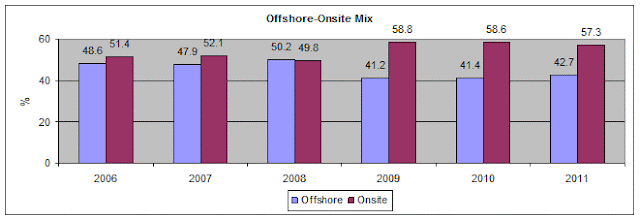HCL Technologies Limited - Financial Performance 2006-2011
Financial Performance:
- 2009 revenue growth was affected due to global recession and Financial crisis and YoY growth was only 17%. YoY growth picked up again in 2010 ( 24%) and 2011 (31%)
- Reduced Operating expenses by almost half in 2009 (17% YoY) but again increased according to the revenue growth.
- Negative YoY growth in net profit in 2008 (-11%) and 2009 (-6%) but profitability significantly increased in 2011 (35% YoY)
HCL Technologies Limited - Geography Mix 2006-2011
Geography Analysis:
- Dependency on the US market is always high and the contribution reduced in 2011 compared 2010 but still 56% revenues come form the region. Peaked in 2010 with 62% of revenues.
- Europe is the second largest market but the contribution fell in 2010 but again increased in 2011 and historically HCL had strong presence in Europe.
- Rest of the world is also increasing compared to previous years and the company is looking to increase further.
HCL Technologies Limited Vertical Revenue Mix 2006-2011
Vertical Analysis:
- Manufacturing is the core vertical but the revenue contribution has been falling.
- Financial Services second largest vertical and growth is constant.
- Telecom is the third largest vertical but revenues have fallen significantly since 2009.
- Retail & CPG have fallen in 2007 and constant since. Healthcare revenues are constant in last two years.
- Energy Utilities and public sector have seen constant growth since 2009.
HCL Technologies Limited -Services Revenue Mix 2006-2011
Services Segment Analysis:
- Custom Application Services is the largest offering followed by Engineering R&D Services. Custom application services saw growth in 2011 and Engineering R&D services fell in 2011 compared to 2010.
- Enterprise Application services is growing constantly in the last three years between 21-24%.
- Infrastructure services are seeing significant growth from 15% in 2008 to 23% in 2011.
- BPO services revenue is falling since 2006 from 13% to 6% in 2011.
HCL Technologies Limited Contract Type 2006-2011
Time & Material contracts are the most preferred. But the Fixed price contracts are also seeing growth since 2008.
HCL Technologies Limited Onsite/Offshore Mix 2006-2011
Onsite has always been dominant contributor for HCL Tech but since 2009 the contribution significantly increased.
Source: Company Investors Site Website : www.hcltech.com/investors



























